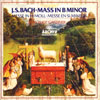Bach Mass in B minor
View record and artist detailsRecord and Artist Details
Composer or Director: Johann Sebastian Bach
Label: Archiv
Magazine Review Date: 2/1986
Media Format: Vinyl
Media Runtime: 0
Mastering:
Stereo
DDD
Catalogue Number: 415 514-1AH2

Tracks:
| Composition | Artist Credit |
|---|---|
| Mass |
Johann Sebastian Bach, Composer
Carol Hall, Soprano English Baroque Soloists Howard Milner, Tenor Johann Sebastian Bach, Composer John Eliot Gardiner, Conductor Lynne Dawson, Soprano Mary Nichols, Mezzo soprano Michael Chance, Alto Monteverdi Choir Nancy Argenta, Soprano Patrizia Kwella, Soprano Richard Lloyd Morgan, Bass Stephen Varcoe, Baritone Wynford Evans, Tenor |
Composer or Director: Johann Sebastian Bach
Label: Archiv
Magazine Review Date: 2/1986
Media Format: Cassette
Media Runtime: 0
Mastering:
Stereo
DDD
Catalogue Number: 415 514-4AH2

Tracks:
| Composition | Artist Credit |
|---|---|
| Mass |
Johann Sebastian Bach, Composer
Carol Hall, Soprano English Baroque Soloists Howard Milner, Tenor Johann Sebastian Bach, Composer John Eliot Gardiner, Conductor Lynne Dawson, Soprano Mary Nichols, Mezzo soprano Michael Chance, Alto Monteverdi Choir Nancy Argenta, Soprano Patrizia Kwella, Soprano Richard Lloyd Morgan, Bass Stephen Varcoe, Baritone Wynford Evans, Tenor |
Composer or Director: Johann Sebastian Bach
Genre:
Vocal
Label: Archiv
Magazine Review Date: 2/1986
Media Format: CD or Download
Media Runtime: 106
Mastering:
Stereo
DDD
Catalogue Number: 415 514-2AH2

Tracks:
| Composition | Artist Credit |
|---|---|
| Mass |
Johann Sebastian Bach, Composer
Carol Hall, Soprano English Baroque Soloists Howard Milner, Tenor Johann Sebastian Bach, Composer John Eliot Gardiner, Conductor Lynne Dawson, Soprano Mary Nichols, Mezzo soprano Michael Chance, Alto Monteverdi Choir Nancy Argenta, Soprano Patrizia Kwella, Soprano Richard Lloyd Morgan, Bass Stephen Varcoe, Baritone Wynford Evans, Tenor |
Author: Nicholas Anderson
As I implied in my opening remarks, this new recording from John Eliot Gardiner and his Monteverdi Choir and English Baroque Soloists is a fine achievement. I have not, in the past, always been convinced by Gardiner's performances of Bach; on several occasions, the results would have been more satisfying if he had let the music unfold with greater natural freedom and not felt the need to tweak rhythms and tempos. Some listeners may like that additional degree of excitement engendered by such methods but my own feeling is that Bach, above all composers, perhaps, does not require 'whipping up' any more than his profound utterances benefit from exaggerated tempos in either direction in order to underline a point. There are no problems of this kind in his B minor Mass which is notably free from intrusive personal mannerisms. Here the many strong points of his direction, amongst which I would single out a vital rhythmic understanding, a clear and positive sense of purpose, and a naturally affective response to Bach's music, combine in forming a concept of the work which not only explores its eneffable mysteries but also savours the magnificence of its architecture.The solo vocal line-up is a strong one and there are few weak moments; most of the soloists sing in the ripieno group as well, though Patrizia Kwella and Lynne Dawson (sopranos) appear to be exceptions to the rule. I especially enjoyed Nancy Argenta's ''Laudamus te'', in which she is lightly partnered by Elizabeth Wilcock's sensitive violin playing, and the singing of Mary Nichols (mezzo-soprano) who provides an expressive and well-balanced partnership with Patrizia Kwella in the ''Et in unum Dominum''. Michael Chance (alto) gives a beautifully controlled account of the ''Agnus Dei'' and there are assured contributions elsewhere from Wynford Evans (tenor) and Stephen Varcoe (bass).
Just occasionally, I'd like to have heard a steadier, more controlled sound from the soloists in ensemble as, for example, in the poignant chromaticisms of the ''Crucifixus''. There is a hint of unsteadiness, too, in the ''Et in spiritum'', but this stems from the instruments, I think, rather than from Richard Lloyd Morgan's (bass) effectively flowing account; but Gardiner captures the 6/8 rhythm of the piece very well.
If I say that the crowning achievement of Gardiner's recording lies in the vitality, accuracy and homogeneity of the ripieno singing it is in no sense intended to underplay the considerable virtues of the soloists and the orchestra; but this, after all, is first a vocal work and foremost a choral one. The ripieno singing at its very best—as it is for example, in the ''Et resurrexit''—is thrilling and gives a fervent imprint to the entire work. There is a spontaneity about this singing to which few listeners, I imagine, could remain indifferent. Parrott's effective range is more tightly constrained than Gardiner's but, though less arresting on first acquaintance, perhaps, is none the less satisfying in the long run. Gardiner's choruses are immediately striking and handled with such skill and rigorous discipline that repeated hearing in no sense diminishes their impact.
It must, by now, be clear that this new performance, like Parrott's, is a splendid achievement. Which of the two you prefer will be a matter of personal taste, but there is much to be said in becoming acquainted with both. No single performance of a work of this distinction and stature, however perceptive, can embrace all its aspects. I have a slight preference for the EMI recording which is a little more spacious, though the DG engineers have achieved a pleasantly natural sound. The CD is comparably satisfactory to the LPs though hardly more so and, until the EMI appears on the new medium, leads a mixed field. Exemplary pressings and presentation.'
Discover the world's largest classical music catalogue with Presto Music.

Gramophone Digital Club
- Digital Edition
- Digital Archive
- Reviews Database
- Full website access
From £8.75 / month
Subscribe
Gramophone Full Club
- Print Edition
- Digital Edition
- Digital Archive
- Reviews Database
- Full website access
From £11.00 / month
Subscribe
If you are a library, university or other organisation that would be interested in an institutional subscription to Gramophone please click here for further information.





